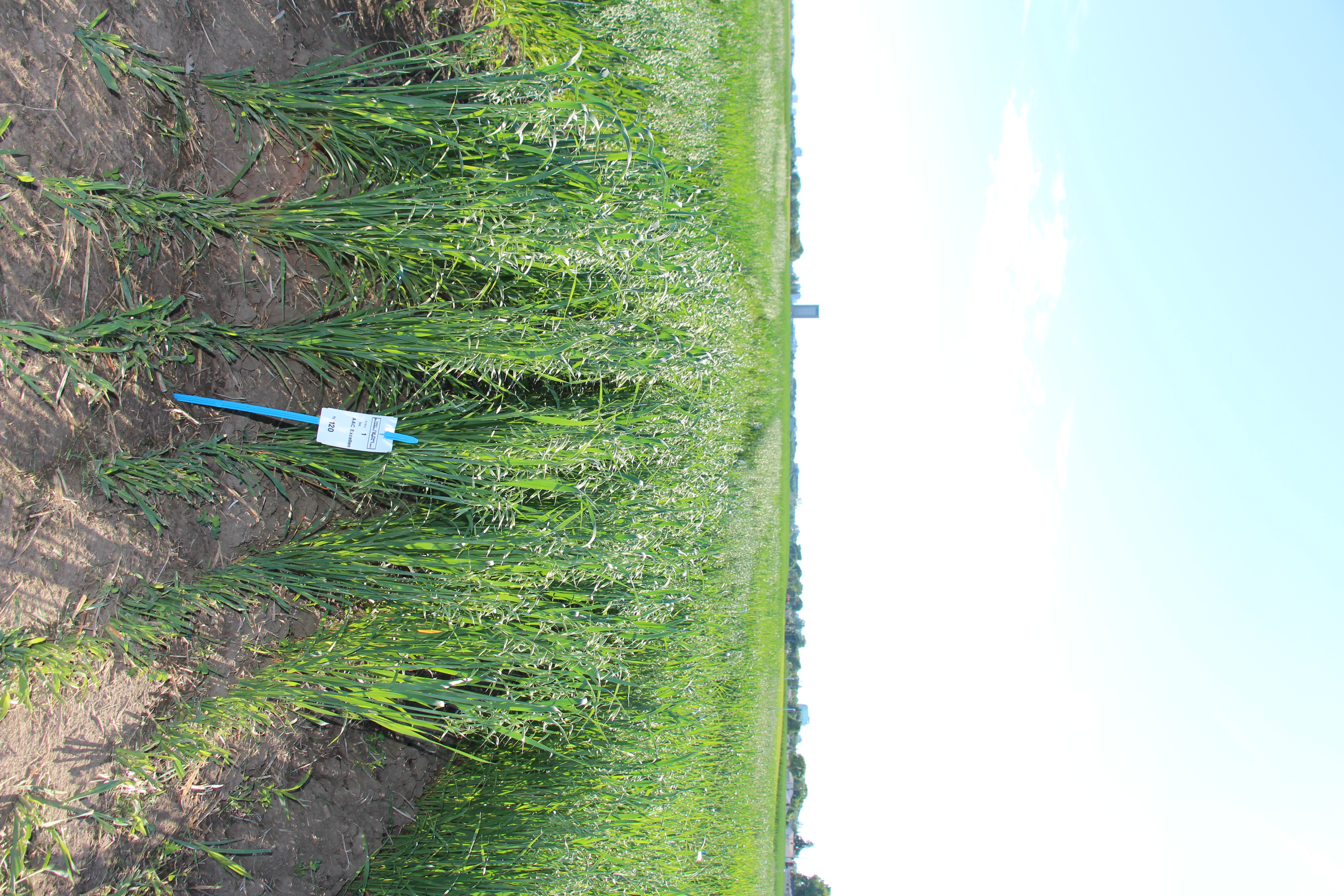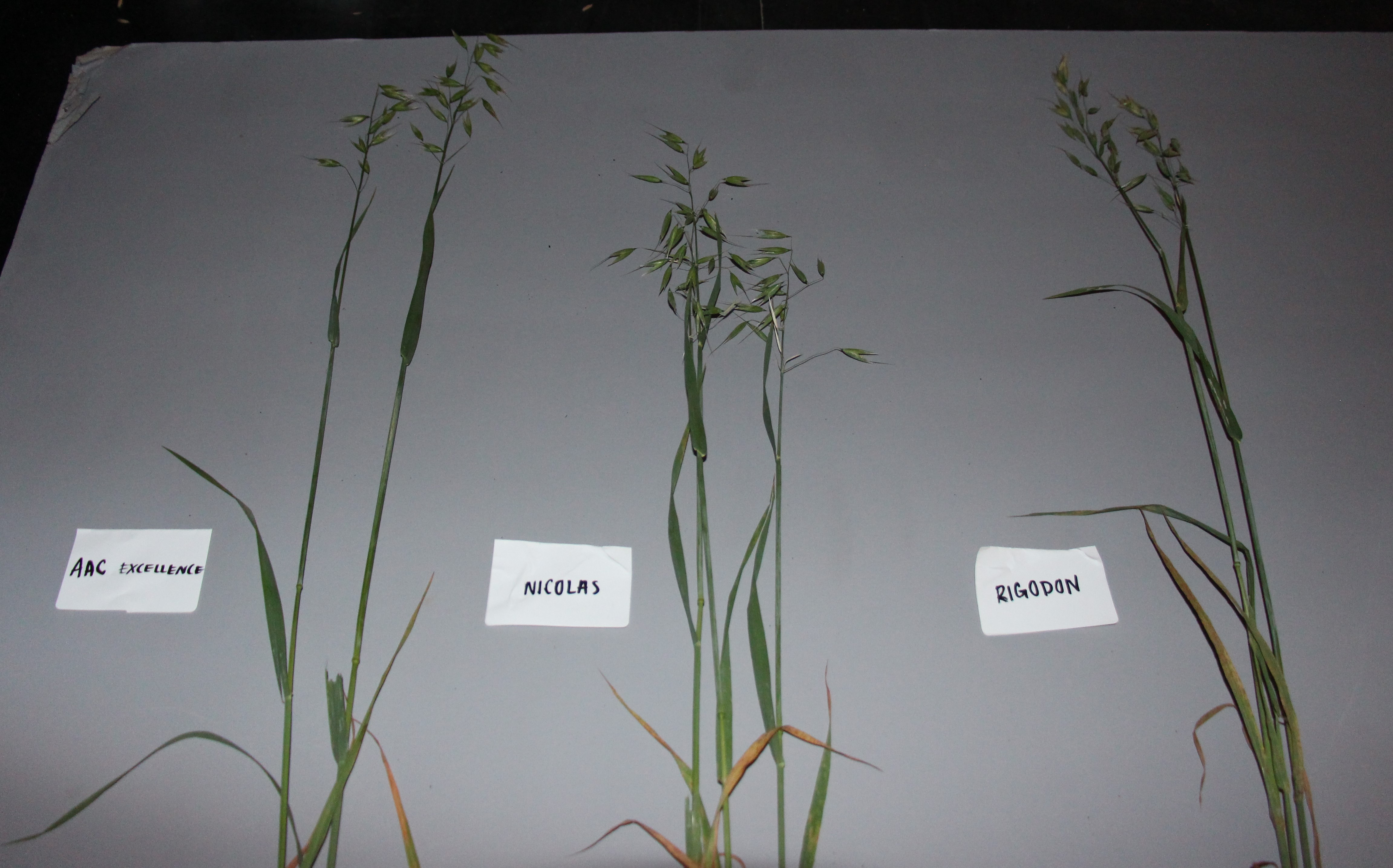AAC Excellence
| Denomination: | 'AAC Excellence' |
|---|---|
| Previously Proposed Denomination: | 'OA1415-2' |
| Botanical Name: | Avena sativa |
| Applicant/Holder: |
Agriculture & Agri-Food Canada, Ottawa Ottawa Research and Development Centre Room 1093A - 960 Carling Avenue Ottawa, Ontario K1A 0C6 Canada |
| Breeder: |
Weikai Yan, Agriculture & Agri-Food Canada, Ottawa, Ontario |
| Agent in Canada: |
Agriculture & Agri-Food Canada Office of Intellectual Property and Commercialization c/o Shannon Whyte 107 Science Place Saskatoon, Saskatchewan S7N 0X2 Canada Tel: (204) 999-9887 |
| Application Date: | 2019-05-15 |
| Provisional Protection:: | 2019-05-15 |
| Application Number: | 19-9859 |
| Grant of Rights Date: | 2024-05-21 |
| Certificate Number: | 7121 |
| Grant of Rights Termination Date: | 2044-05-21 |
Variety Description
Varieties used for comparison: 'AC Rigodon' and 'AAC Nicolas'
Summary: At the 5 to 9 tiller stage, the pubescence on the lower leaf sheath of 'AAC Excellence' is absent or very sparse while it is sparse for 'AAC Nicolas'. The pubescence on the lower leaf blade of 'AAC Excellence' is absent or very sparse while it is sparse for 'AAC Nicolas'. At the time of booting, the leaf of 'AAC Excellence' is medium green while that of 'AC Rigodon' is dark green. At the green stage, the leaf of 'AAC Excellence' has medium glaucosity while that of 'AAC Nicolas' has weak glaucosity. 'AAC Excellence' has a low frequency of plants with recurved flag leaves while 'AAC Nicolas' has a medium frequency of plants with recurved flag leaves. The plants of 'AAC Excellence' head before the plants of 'AAC Nicolas' and later than those of 'AC Rigodon'. The plants of 'AAC Excellence' are taller than those of 'AAC Nicolas'. The glume of 'AAC Excellence' has medium to strong glaucosity while that of 'AAC Nicolas' has weak to medium glaucosity. The lemma of 'AAC Excellence' has a weak tendency to be awned whereas that of 'AAC Nicolas' has a medium tendency to be awned.
Description:
PLANT: spring hulled type, intermediate growth habit at 5 to 9 tiller stage, low frequency of plants with recurved flag leaves at booting
STEM: absent to sparse pubescence above and below the upper culm node
LOWER LEAF: absent or very sparse pubescence on sheath and blade
LEAF: medium green, absent to very sparse pubescence on margin of leaf below flag leaf, medium glaucosity at green stage
PANICLE: equilateral/symmetrical orientation, medium to dense, semi-erect attitude of branches, less than 30 degree angle between rachis and dominant side branch
SPIKELET: two grains
LEMMA: small extent of lateral overlap on palea, white at maturity, absent to very sparse pubescence on lateral and dorsal surface, weak tendency to be awned
KERNEL (PRIMARY KERNELS FROM UPPER SPIKELETS): basal hairs absent, cream colour
GROAT: medium pubescence
Origin & Breeding History: 'AAC Excellence' (experimental designations 'OA1415-2' and '09S03-54-7') originated from a four way cross conducted at the Agriculture & Agri-Food Canada's Ottawa Research and Development Centre in Ottawa, Ontario. Two initial crosses were conducted, the first cross between 'AAC Roskens' and 'MN07205' and the second cross between 'AC Rigodon' and 'HiFi'. The progeny resulting from these initial crosses were subsequently crossed in 2009. Seed from 123 F1 plants were grown in single F2 rows in 2010. Panicles harvested from visually selected rows were grown in 185 F3 panicle-hills in 2011. Sixty-eight F3:4 lines were selected and grown in observation plots in 2012 with 14 F3:5 lines selected and advanced to the 2013 Home test at four locations across Eastern Canada. Four of these lines were evaluated in the Preliminary/Enabling Collaborative Oat Research Enterprise tests across Canada. One line designated 'OA1415-2' was entered in the Agriculture & Agri-Food Canada's Ottawa Research and Development Centre's oat Registration trials in 2015, and in the Quebec provincial oat registration test in 2016 to 2018. 'AAC Excellence' was selected based on plant height, maturity, standability, disease resistance, perceived yield potential as well as kernel size, uniformity and compositional quality. Fifty F7 panicles randomly chosen from the 2014 seed plot were grown in fifty hills in 2015 of which 18 were harvested individually. In 2016, these lines were grown in individual plots, harvested separately and grown into larger individual plots in 2017. Five F7:9 lines, selected that had similar emergence, crown rust resistance, panicle characteristics, and plant height were used to produce pre-breeder seed in 2018 with Breeder seed produced in Ottawa, Ontario in 2019.
Tests & Trials: The comparative trials for 'AAC Excellence' were conducted at the Agriculture & Agri-Food Canada Ottawa Research and Development Centre in Ottawa, Ontario in 2019 and 2021. There were 4 replicates arranged in a RCB design. The plots were 3.8 metres squared and consisted of six 3.8 metre long rows with 18 centimetre inter-row spacing. The seeding density was 330 seeds per metre squared resulting in a minimum of 5016 plants per variety. The measured characteristics were based on a minimum of 20 measurements per variety per year. The mean differences were significant at the 5% probability level based on a Student's t-test.
Comparison tables for 'AAC Excellence' with reference varieties 'AC Rigodon' and 'AAC Nicolas'
Days to heading (days from planting to when 50% of panicles are fully emerged)
| 'AAC Excellence' | 'AC Rigodon' | 'AAC Nicolas' | |
|---|---|---|---|
| mean 2019 | 62 | 59 | 64 |
| mean 2021 | 58 | 55 | 61 |
Plant height (culm plus panicle) (cm)
| 'AAC Excellence' | 'AC Rigodon' | 'AAC Nicolas' | |
|---|---|---|---|
| mean 2019 | 82.5 | 76.3 | 67.7 |
| std. deviation 2019 | 4.9 | 8.9 | 5.1 |
| mean 2021 | 115.0 | 119.0 | 94.3 |
| std. deviation 2021 | 3.9 | 4.5 | 5.8 |
Click on image for larger view

Oat: 'AAC Excellence'
Click on image for larger view

Oat: 'AAC Excellence'
Click on image for larger view

Oat: 'AAC Excellence' (left) with reference varieties 'AAC Nicolas' (center) and 'AC Rigodon'
- Date modified: